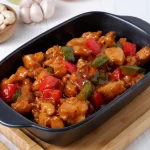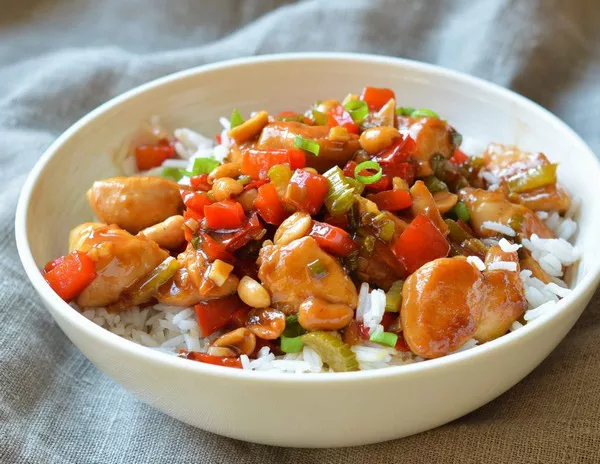Chinese cuisine is renowned for its rich history and diverse flavors. One of the most popular dishes that has gained international recognition is Kung Pao Chicken. This delectable stir-fry dish, with its perfect balance of sweet, savory, and spicy flavors, is a favorite among food enthusiasts worldwide. In this comprehensive guide, we will walk you through the art of making Kung Pao Chicken in your own kitchen. Whether you’re a seasoned chef or a novice cook, this article will provide you with all the information you need to create an authentic and delicious Kung Pao Chicken dish.
History and Origins of Kung Pao Chicken
Before we dive into the recipe and cooking techniques, let’s take a moment to appreciate the historical context of Kung Pao Chicken. Understanding its origins and cultural significance can enhance your appreciation of this iconic Chinese dish.
Kung Pao Chicken, also known as Gong Bao or Kung Po, has its roots in Sichuan cuisine, which is renowned for its bold and spicy flavors. The dish is named after Ding Baozhen, a Qing Dynasty official who held the title “Gong Bao.” It is said that he loved this particular chicken dish, and it was named in his honor. Over time, Kung Pao Chicken gained immense popularity not only in China but also around the world due to its unique blend of flavors and textures.
Kung Pao Chicken

Kung Pao Chicken is a popular Chinese stir-fry dish known for its bold, spicy, and savory flavors. Here's a basic recipe for making Kung Pao Chicken at home. You can adjust the spiciness level to your preference by controlling the amount of chili peppers you use.
For the Marinade:
- 1 lb (450g) boneless, skinless chicken breasts or thighs, cut into bite-sized pieces
- 1 tablespoon soy sauce
- 1 teaspoon cornstarch
For the Sauce:
- 2 tablespoons soy sauce
- 1 tablespoon rice vinegar
- 1 tablespoon sugar
- 1 teaspoon cornstarch
For the Stir-fry:
- 2 tablespoons vegetable oil
- 1/2 cup unsalted peanuts
- 2-4 dried red chili peppers, depending on your spice preference (you can adjust this)
- 3 cloves garlic, minced
- 1-inch piece of ginger, minced
- 1 bell pepper, diced
- 1/2 cup diced onion
- 2 green onions, sliced (green and white parts separated)
- Sichuan peppercorns (optional, for an authentic numbing flavor)
-
In a bowl, combine the chicken pieces with 1 tablespoon of soy sauce and 1 teaspoon of cornstarch. Mix well and let it marinate for about 15 minutes.
-
In a small bowl, mix together the soy sauce, rice vinegar, sugar, and 1 teaspoon of cornstarch. Set aside.
-
Heat a dry wok or large skillet over medium-high heat. Add the peanuts and stir-fry for a few minutes until they are lightly toasted. Remove the peanuts from the wok and set them aside.
-
Add 2 tablespoons of vegetable oil to the wok and heat it over high heat. Once hot, add the dried red chili peppers and stir-fry for about 30 seconds to infuse the oil with their flavor.
-
Add the marinated chicken and stir-fry until it's cooked through and slightly browned. Remove the chicken from the wok and set it aside.
-
In the same wok, add a bit more oil if needed. Add the minced garlic, ginger, and the white parts of the green onions. Stir-fry for about 30 seconds.
-
Add the diced bell pepper and onion and stir-fry for a few minutes until they start to soften.
-
Return the cooked chicken to the wok. Add the sauce and toss everything together.
-
Return the toasted peanuts to the wok and add Sichuan peppercorns if you like the numbing flavor. Toss everything together and cook for an additional minute.
-
Remove the wok from the heat and garnish with the green parts of the sliced green onions. Serve your Kung Pao Chicken hot over rice or noodles.
Tips for Perfect Kung Pao Chicken
To make the perfect Kung Pao Chicken, consider these tips:
Use Quality Ingredients: Start with fresh and high-quality ingredients, especially the chicken, which should be tender and boneless.
Prepare Everything in Advance: Kung Pao Chicken is a quick stir-fry dish, so have all your ingredients ready before you start cooking to avoid overcooking or burning any elements.
Cut Ingredients Uniformly: Cut the chicken, vegetables, and peanuts into uniform sizes to ensure even cooking.
Marinate the Chicken: Marinating the chicken with soy sauce and cornstarch adds flavor and helps to keep the meat tender.
Adjust the Spice Level: The heat in Kung Pao Chicken mainly comes from dried red chili peppers. Adjust the quantity of peppers to suit your spice preference. You can remove the seeds to reduce the heat while retaining the flavor.
Dry Roast the Peanuts: Toasting the peanuts in a dry pan without oil enhances their flavor and gives them a nice crunch. Be careful not to over-toast them as they can become bitter.
Sichuan Peppercorns (optional): For an authentic flavor, consider adding a pinch of Sichuan peppercorns. These provide a unique numbing sensation.
Use a Wok or a Large Skillet: A wok is ideal for stir-frying because of its shape, but a large skillet works well too. Make sure it’s hot before adding the ingredients.
Stir-Fry in Batches: If you overcrowd the wok, the ingredients will steam instead of stir-fry. Cook the chicken in batches if necessary.
Balanced Sauce: Adjust the sauce’s sweetness, saltiness, and acidity to your taste. You can add a bit more sugar, soy sauce, or vinegar to achieve the balance you prefer.
Thicken the Sauce: If your sauce is too thin, you can mix a little more cornstarch with water and add it to the stir-fry. Make sure to mix it well to avoid lumps.
Garnish with Green Onions: Adding sliced green onions, especially the green parts, at the end provides a fresh and vibrant flavor and color.
Serve Immediately: Kung Pao Chicken is best when served hot and fresh. Overcooking can make the chicken tough and the vegetables mushy.
Pair with Steamed Rice or Noodles: Kung Pao Chicken is commonly served with steamed white rice, but it can also be enjoyed with noodles.
Experiment and Customize: Feel free to customize the recipe to your liking. You can add other vegetables like zucchini, mushrooms, or water chestnuts, or adjust the level of spiciness and sweetness based on your preferences.
By following these tips and practicing your stir-frying skills, you can make a delicious and perfect Kung Pao Chicken at home.
Variations and Tips
1. Tofu Kung Pao: For a vegetarian version, replace the chicken with tofu cubes and follow the same recipe, adjusting the cooking time as needed.
2.Cashew Kung Pao: If you prefer cashews over peanuts, feel free to use them as a substitution.
3. Adjusting Spiciness: You can control the level of spiciness by adding more or fewer dried chilies. Remove the seeds for a milder flavor.
4. Balance Flavors: Taste your Kung Pao Chicken throughout the cooking process and adjust the balance of sweet, savory, and spicy flavors by adding more soy sauce, sugar, or vinegar as needed.
5. Garnishes: Fresh cilantro leaves, toasted sesame seeds, or chopped scallions can be used as garnishes to enhance the visual appeal.
FAQs About Making Kung Pao Chicken
Q1. What does “Kung Pao” mean?
“Kung Pao” is the name of a traditional Chinese dish known for its spicy and savory flavor. It’s also spelled as “Gong Bao” or “Kung Po.” The name is often associated with Ding Baozhen, a late Qing Dynasty official, but there’s some debate about its origin.
Q2. Can I use other proteins instead of chicken?
Yes, you can substitute chicken with other proteins like shrimp, beef, tofu, or even a combination of different meats. The cooking times may vary depending on the protein you choose.
Q3. Is Kung Pao Chicken always spicy?
Kung Pao Chicken is typically a spicy dish due to the use of dried red chili peppers. However, you can adjust the level of spiciness by adding fewer peppers or removing the seeds.
Q4. What are Sichuan peppercorns, and can I omit them?
Sichuan peppercorns are not traditional in all Kung Pao Chicken recipes, but they can add a unique numbing sensation. You can omit them if you prefer, and the dish will still be delicious.
Q5. Can I make a vegetarian or vegan version of Kung Pao Chicken?
Yes, you can make a vegetarian or vegan Kung Pao dish using tofu or seitan as the protein. Use soy sauce instead of oyster sauce and consider a vegan-friendly sugar substitute.
Q6. What are the best types of dried chili peppers to use?
Commonly used dried chili peppers for Kung Pao Chicken include Chinese red chili peppers like Sichuan or Thai bird’s eye chilies. You can use other varieties depending on your heat preference.
Q7. Can I make Kung Pao Chicken in advance?
While Kung Pao Chicken is best when served fresh, you can prepare the sauce, cut the ingredients, and marinate the chicken in advance to save time. However, stir-frying should be done just before serving to maintain the dish’s texture and flavor.
Q8. What should I serve with Kung Pao Chicken?
Kung Pao Chicken is commonly served with steamed white rice, but you can also pair it with fried rice, noodles, or other side dishes like sautéed vegetables.
Q9. Is there a low-sodium version of Kung Pao Chicken?
To reduce sodium, use reduced-sodium soy sauce and consider adjusting the amount of soy sauce in the recipe. You can also reduce the saltiness by adding a bit more water to the sauce.
Q10. How do I adjust the sweetness and saltiness of the sauce?
You can easily adjust the sauce’s sweetness and saltiness by adding more or less sugar and soy sauce, respectively. Taste the sauce as you go and make the necessary adjustments.
Q11. Is Kung Pao Chicken the same as General Tso’s Chicken?
No, they are different dishes. Kung Pao Chicken is known for its spiciness, while General Tso’s Chicken is typically sweet and tangy, with a crispy fried chicken coating.
See Also: How to Make General Tso’s Chicken: A Culinary Delight
Conclusion
Kung Pao Chicken is a delicious and iconic Chinese dish that combines a medley of flavors and textures, making it a favorite for both novice and experienced home cooks. By following the steps outlined in this comprehensive guide, you can master the art of making authentic Kung Pao Chicken in your own kitchen. Experiment with the ingredients and adjust the spice levels to suit your taste. Whether you’re enjoying it with family or impressing guests, this classic dish is sure to leave a lasting impression on your taste buds. Embrace the history and tradition of Chinese cuisine, and savor the exquisite flavors of Kung Pao Chicken.

